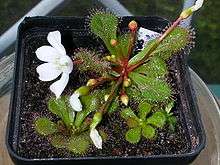Drosera aberrans
| Drosera aberrans | |
|---|---|
 | |
| Scientific classification | |
| Kingdom: | Plantae |
| (unranked): | Angiosperms |
| (unranked): | Eudicots |
| (unranked): | Core eudicots |
| Order: | Caryophyllales |
| Family: | Droseraceae |
| Genus: | Drosera |
| Subgenus: | Ergaleium |
| Section: | Erythrorhiza |
| Species: | D. aberrans |
| Binomial name | |
| Drosera aberrans (Lowrie & Carlquist) Lowrie & Conran | |
| Synonyms | |
| |
Drosera aberrans is a perennial tuberous species in the genus Drosera that is native to New South Wales, South Australia, and Victoria. It grows in a rosette 3 to 5 cm in diameter with green, orange-yellow, or red leaves. It is native to southern inland South Australia, southern and central Victoria, and one single collection from New South Wales. It grows in a variety of soils from sand to laterite gravel and limestone clay in mallee woodland, heathland, and open forests. It flowers from July to September.[1]

It was perhaps first illustrated by Ferdinand von Mueller in 1879, which he identified as Drosera whitackeri [sic], though Allen Lowrie and John Godfrey Conran note that this could represent artistic license and may not have been drawn from an actual specimen. Lowrie and Sherwin Carlquist first formally described this taxon in 1992 as a subspecies of Drosera whittakeri. Lowrie and Conran reviewed the specimens of D. whittakeri in 2008 and elevated subsp. aberrans to species rank based on the colony-forming morphology of this species.[1]
See also
References
- 1 2 Lowrie, A, and J. G. Conran. 2008. A review of Drosera whittakeri s. lat. (Droseraceae) and description of a new species from Kangaroo Island, South Australia. Telopea, 12(2): 147-165.
External links
![]() Media related to Drosera aberrans at Wikimedia Commons
Media related to Drosera aberrans at Wikimedia Commons
http://www.tuberous-drosera.net/aberrans.htm